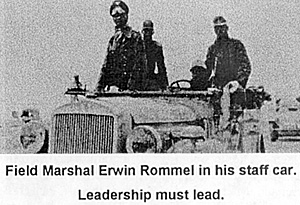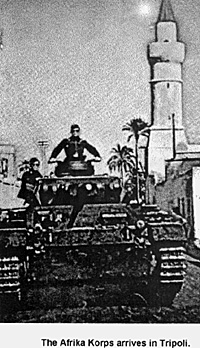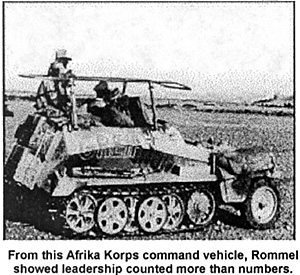 As if it weren't always summer in the Egyptian
desert, we have here a battle that was fought in the
summer in the desert. And yes, one side was primarily
Mad Dogs & Englishmen. Everyone knows that the
Battle of El Alamein was a turning point of World War II
in North Africa, but a more desperate gambit was fought
As if it weren't always summer in the Egyptian
desert, we have here a battle that was fought in the
summer in the desert. And yes, one side was primarily
Mad Dogs & Englishmen. Everyone knows that the
Battle of El Alamein was a turning point of World War II
in North Africa, but a more desperate gambit was fought
Following the fall of Tobruk in Libya on June 21, 1942 Rommel was promoted to the rank of Field Marshal, and he wanted, in spite of the enormous losses the Afrika Korps had sustained in the Battle of Gazala and Tobruk, to follow the fleeing 8th Army into Egypt. Tactically, that was the best course of action. On the way there at Mersa Matruh.
Field Marshal Kesselring, who was in charge of the Mediterranean, wanted Rommel to rest and refit his army before invading Egypt. He wanted to use the Luftwaffe and all available naval units to take Malta, and thereby secure Rommel's logistical communications. Strategically, that was the best course of action. Agreeing with Kesselring was the Italian General Staff, the German Naval Staff, and General von Rintelen, Germany's military attachd to Rome. The only person to agree with Rommel was Hitler.
 Rommel was given the green light in spite of the
depleted condition of the Afrika Korps.
Rommel was given the green light in spite of the
depleted condition of the Afrika Korps.
Rommel's reconnaissance units reached the outskirts of Mersa Matruh on the evening of June 25, and he announced that he would attack the next day. Awaiting Rommel in the coastal strip was the 10th Corps. The 10th Indian Division was fortified in Mersa Matruh, with the 50th British Division and the 5th Indian Division echeloned back along the coast. In the flat area between the low coastal strip and the Sidi Hamza Escarpment were two columns from the 29th Indian Brigade behind minefields. Atop the escarpment was 13th Corps, consisting of the New Zealand Division and the British 1st Armored Division.
According to Rommel's plan, which lacked the benefit of a reconnaissance, he would drive between all of the British infantry in Mersa Matruh and the British armor atop the escarpment. The he would defeat the armor and trap their infantry. Unfortunately, that was not exactly where the British were, and the entire Afrika Korps of the 15th Panzer, 21st Panzer and 90th Light Divisions only had a total of 44 panzers.
The 90th Light and 21st Panzer Divisions rapidly eliminated the two columns in the middle, called Leathercol and Gleecol, respectively. The Italian infantry divisions that were supposed to cover the front of Mersa Matruh were not yet up.
The 90th Light Division, which had been reduced to approximately 1,600 men, moved beyond the British and reached the coastal road 20 miles east of Mersa Matruh. In the open desert they had no way of resisting the three infantry divisions it had just 'cut off'.
The 21st Panzer Division, which was down to 23 tanks and 600 panzer grenadiers (motorized infantry), looped around the New Zealand division and attacked. Had both sides had better intelligence, it would have looked like a terrier, viciously biting the calf of a dinosaur.
Up on the escarpment, the 15th Panzer Division, cut off from the other divisions by the entire British 13th Corps and the escarpment, was attacking the British lst Armored Division. The British had 159 tanks, including 60 of the new American Grant tanks. That night Rommel sent out orders to the Afrika Korps to prepare to pursue the British.
The British command looked at the situation in which they had the Afrika Korps divided, and half of it between the two halves of their much superior force. Alas, the British saw that they were divided, and the coastal road had been cut. Atop the escarpment, l3th Corps retreated. 10th Corps only found out about their retreat much later. Rather than surrender like the Tobruk garrison, they decided to fight their way out at night. One of their columns blundered right through Rommel's headquarters, and staff officers like Von Mellenthin had to take up a sub-machinegun to defend himself.
The Battle of Mersa Matruh had cost the British the chance of crushing what was left of the Afrika Korps. They had also lost over 8,000 prisoners, and lots of vehicles and supplies.
 Alas for Rommel, his victory
was just enough to convince him that he could make it
to the Nile and the Suez Canal. Had he permitted
Kesselring to take Malta, he would have had the
supplies and reinforcements to win at El Alamein.
Alas for Rommel, his victory
was just enough to convince him that he could make it
to the Nile and the Suez Canal. Had he permitted
Kesselring to take Malta, he would have had the
supplies and reinforcements to win at El Alamein.
Wargaming the Desert War is the best place for tank vs. tank, without very much to get in the way. We have a host of micro-armor for the Desert War, but there are also two board wargames I'd like to note. Avalon Hill did Afrika Korps, which introduced me to the use of logistics when I was young. Essentially, if you can get the Axis player to burn up his supply units driving you back, you can hold them when the Axis runs out of supplies. Rommel had the same problem.
SPI's Campaign for North Africa is a great resource. The 5 maps are the very best, and the data alone is worth the price. It's detailed enough to train officer's in logistics. Not only do you have to keep track of the normal items, but it differentiates between brackish water and pure water for cooking. The Italians even need additional water in order to prepare their pasta. Now that's detail!
Back to Novag's Gamer's Closet Summer 2002 Table of Contents
Back to Novag's Gamer's Closet List of Issues
Back to MagWeb Master Magazine List
© Copyright 2002 by Novag
This article appears in MagWeb.com (Magazine Web) on the Internet World Wide Web. Other articles from military history and related magazines are available at http://www.magweb.com